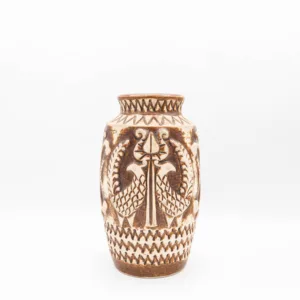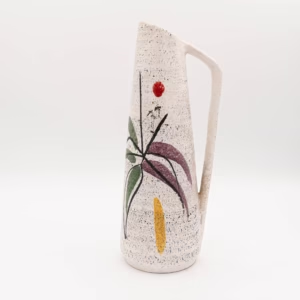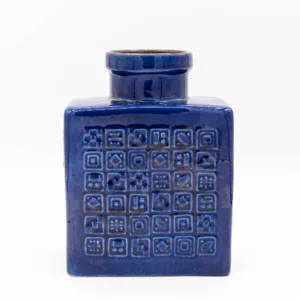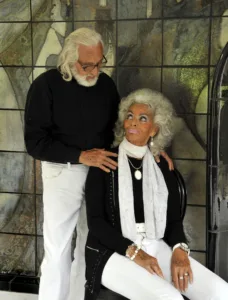West Germany Art Pottery
And It’s Artists
….
Bodo Mans (1935–2001)
Bodo Mans (1935–2001) was a pivotal figure in the world of West German art pottery, celebrated for his innovative designs and lasting influence on mid-century ceramics.
Born in 1935, Mans began his creative journey apprenticing as a window dresser and decorative painter from 1949 to 1951. He then trained as a graphic designer in Cologne before pursuing ceramics at the technical school in Höhr-Grenzhausen between 1954 and 1956 – a renowned institution in the heart of Germany’s ceramics industry.
After completing his studies, Mans gained practical experience as a ceramic painter at Keto Keramik and briefly worked at the famed Madoura workshop in Vallauris, France, where Picasso created his ceramics. This exposure to avant-garde art and international techniques deeply influenced his approach.
Upon returning to Germany, he had short stints at Ruscha Keramik and Marei Keramik, before beginning his long association with Bay Keramik in 1959. Initially freelancing, he became a permanent designer for Bay in 1962, a position he held until his retirement in 1975.
Mans is best known for his bold, colourful, and playful designs, such as the “Brasil,” “Kongo,” “Reims,” “Istanbul,” and “Ravenna” series, or his designs inspired by the Italian company Bitossi, which are now highly collectible. His work is noted for its technical precision, inventive use of form, and vibrant glazes, reflecting both modernist and traditional influences. In 1962, he co-founded the ceramic group “Muffel,” which helped bring contemporary ceramics to wider public attention.
After leaving Bay, Mans continued as a freelance designer, painter, and graphic artist. His career demonstrates a synthesis of art history, modern design, and technical mastery, making him one of the most influential designers in West German pottery
Designs by Bodo Mans


Heinz Siery (1927–2022)
Heinz Siery was a highly influential designer in the world of West German art pottery, renowned for his harmonious proportions and modernist sensibilities. While specific details about his early life and formal education remain scarce in public records, Siery’s professional legacy is well documented through his prolific work, particularly at Carstens Tönnieshof and Scheurich – two of the most significant West German ceramics manufacturers of the mid-20th century.
Siery began his tenure at Carstens in 1959, quickly establishing himself as a leading creative force. His designs from the early 1960s are characterized by balanced forms and innovative surface treatments, often integrating geometric patterns and pastel colour palettes that reflected the evolving tastes of post-war Europe. Notable series attributed to Siery include “Brasilia” and “Manilla,” both of which exemplify his ability to merge sculptural form with decorative artistry. The “Europa” series, with its moulded geometric motifs inspired by ancient cultures, further highlights his engagement with art historical references and the broader modernist movement.
His work is celebrated for its clarity, modernity, and the integration of functional and aesthetic concerns – a hallmark of mid-century design ethos.
Later, Siery contributed iconic shapes to Scheurich, such as the model 271-22 or 275-28, which became emblematic of the Fat Lava era with its striking glazes and dynamic silhouettes.
From 1969 on, he and his wife Ingrid – also a ceramic artist in her own rights, working for Carstens and Wächtersbach – started to work independently in their own “Atelier Syré”. Here, they started to work both for clients and their own large-scale bronze sculptures.
Heinz Siery’s influence extended beyond individual pieces; his approach helped shape the direction of West German pottery during a period of intense artistic cross-pollination, drawing on traditions in sculpture, painting, and architecture to create vessels that were both utilitarian and works of art.
His legacy endures in the continued appreciation and collectability of his designs among enthusiasts and collectors worldwide.
Designs by Heinz Siery





